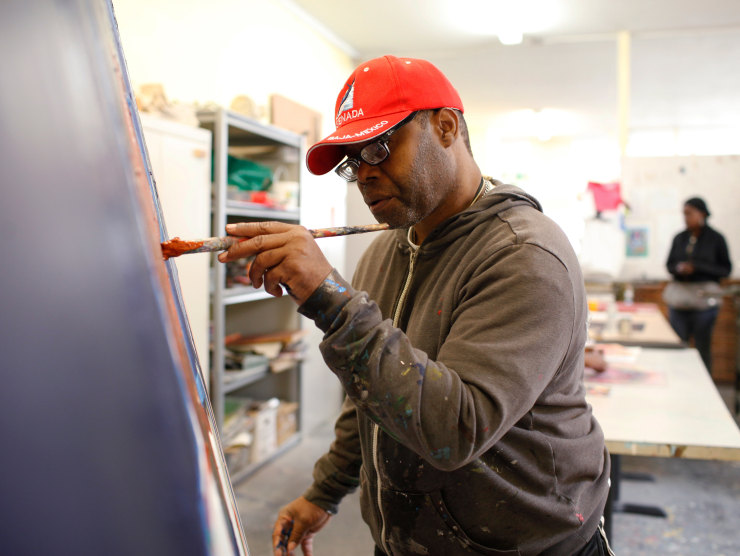
Featuring Billy White
Featuring Mike Ousley, Ayin Es, Will Thomson, Timothy Wehrle
Stellarhighway was established in 2021 as a project space for viewing objects by a wide range of makers, especially those who are otherwise professionals (i.e. not full-time artists). While we focus on fine art created by living artists, our interests are broad and geared toward finding out more about the evolution of humanity’s mind, body and psyche.
Timothy Wehrle
Timothy Wehrle (b. 1978; Burlington, IA) creates obsessive, intricate drawings, paintings, and sculptures that blend nostalgic yearnings with stark depictions of everyday life and psychological states. His work is influenced by Persian miniatures, comic books, sacred mandalas, folk art quilting, and the kaleidoscopic drawings of Adolph Wölfli and Augustin Lesage. Wehrle’s complex and layered images explore subjectivity and personal experience, often positioning the artist as the central figure. Wehrle held a solo exhibition at the John Michael Kohler Art Center in Sheboygan, WI, and has worked with galleries and institutions including Cavin Morris, New York, NY; Shrine, New York, NY; PPOW, New York, NY; and Dieu Donné, New York, NY.
"Tim's paintings and drawings are densely packed with different kinds of narratives that reflect the world we all share. I can see internal dialogues, anxieties, desires, and giddiness, all happening simultaneously within the characters that populate his rich world." —Jeffrey Gibson, artist
Will Thomson
Will Thomson (b. 1992; London, UK) is a self-taught artist whose work explores the physical and metaphorical barriers that shape our relationship to the world. His multi-layered paintings reside in their own processes: they are a series of corrections and alterations, an attempt to make sense of what came before and to recognize how history and experience inform understanding of our environment. Recent exhibitions include Two Hundred Pounds Of Cement at Problem Library, San Francisco, CA; Noontime Ghosts at Eve Leibe Gallery, London, UK; Pathways On Paper at South Parade, London, UK; and Future Fossils with Alice Black Gallery, London, UK. The artist is based in London.
"Some barriers are intended to keep us out. [...] This distance from the landscape changes our vision of it too. In real life as in paintings, hills, from far away, appear blue. The other kind of barrier—windows, screens, canvases—allow us to experience the landscape but keep us detached from its physical effect." —Jack Dunleavy, for Two Hundred Pounds of Cement at Problem Library, San Francisco, CA
Mike Ousley
Mike Ousley (b. 1976; Hippo, KY) paints a direct commentary on Appalachian life and folk traditions, though their simplicity belies their depth. Ousley has painted since childhood, and though trained (MFA, University of Cincinnati), he foils Western European traditions with the folk style of his youth. Having grown up in a small coal town in Southeastern Kentucky listening to stories told by friends and family, he credits the visionary artists and rich heritage of the region as his primary influence. Recent exhibitions include Mike Ousley at Haley Fine Art, Sperryville, VA; Tales from the Deep Dark Hills at James Barron Art, CT; In Some Dark Holler at Stellarhighway, NY; Nine Lives at Fortnight Institute, NY; From These Hills at the William King Museum of Art, VA, curated by Michael Rooks; and Something on the Wind at Morehead State University, Morehead, KY. His work has been featured twice in ArtMaze Magazine and included in David Zwirner’s Platform. Ousley has been a resident at the Huntington Museum of Art, studying with Alfred Leslie; Arc of Appalachia; and North Mountain. His work can be found in numerous private collections, as well as the public collections of Ashland Community College, Highlands Regional Medical Center, Morehead State University, and Ohio State University.
"In his approach to folk art, Ousley is fluid rather than ethnographic, taking liberties as a storyteller to embellish and heighten his paintings to maximum effect. [...] Even if it’s tempting to compare Ousley’s work to conventional art world figures, it would be wrong to characterize Ousley as anything but a Kentucky painter. His work draws deeply from the holler and is infinitely proud of it." —Harry Tafoya, for In Some Dark Holler at Stellarhighway, Brooklyn, NY
Ayin Es
Ayin Es (b. 1968; Los Angeles, CA) is a nonbinary artist based in Joshua Tree, CA. Their work explores the intentional and unintentional aspects of self, identity, and spirituality. Growing up in their family’s garment business, Es fled an abusive situation at the age of fifteen, started making art, and became a drummer in a punk band, touring North America and topping charts. Es was diagnosed with physical and mental disabilities in their 30s, at which point they stopped touring to dedicate themself wholly to their studio.
Recent exhibitions include those at Craig Krull Gallery, Shulamit Nazarian Gallery, UCLA Geffen School of Medicine, Torrance Art Museum, Lancaster Museum of Art and History, Craft Contemporary, and University of Wisconsin. Es’ work resides in museums such as the Getty, Centre Pompidou/Bibliotheque Kandinsky, Brooklyn Museum, National Museum of Women in the Arts, Otis College of Art & Design, Yale University/Beinecke Library, Museum of Modern Art, UC San Francisco Precision Cancer Center, Cedar-Sinai Medical Center, and LAC+USC Medical Center.
A two-time recipient of ARC Grants from the Durfee Foundation, Es has also won a Pollock-Krasner Fellowship, the Wynn Newhouse Award, grants from the National Arts and Disability Center/California Arts Council, Asylum-Arts in Brooklyn, NY, and the Bruce Geller Memorial Award from the American Jewish University. Their work has been reviewed or published in New American Paintings, Artillery, LA Times, ArtScene, LA WEEKLY, ArtNowLA, ArtLTD, Art&Cake, and WhiteHot Magazine.
"An autodidact, Es has long embodied their interests and their struggles—in painted and drawn and even sculpted and sewn imagery—darkly whimsical forms and figures whose deft fluidity have the eye ‘going for a walk with a line’ (in the words of Paul Klee, a strong influence on Es) but aggressively trouble the mind." —Peter Frank, Los Angeles-based art critic and curator.